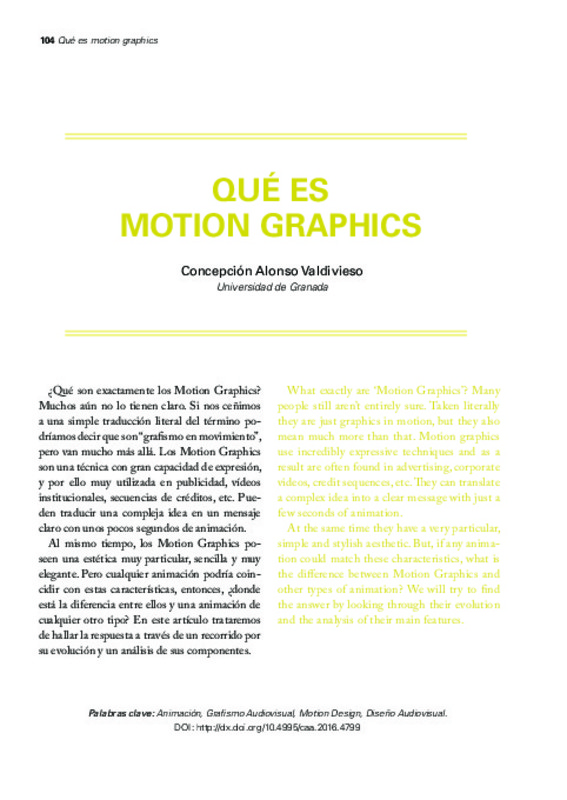JavaScript is disabled for your browser. Some features of this site may not work without it.
Buscar en RiuNet
Listar
Mi cuenta
Estadísticas
Ayuda RiuNet
Admin. UPV
Qué es Motion Graphics
Mostrar el registro sencillo del ítem
Ficheros en el ítem
| dc.contributor.author | Alonso Valdivieso, Concepción
|
es_ES |
| dc.date.accessioned | 2017-04-07T07:05:22Z | |
| dc.date.available | 2017-04-07T07:05:22Z | |
| dc.date.issued | 2016-05-16 | |
| dc.identifier.issn | 2173-6049 | |
| dc.identifier.uri | http://hdl.handle.net/10251/79544 | |
| dc.description.abstract | [EN] What exactly are ‘Motion Graphics’? Many people still aren’t entirely sure. Taken literally they are just graphics in motion, but they also mean much more than that. Motion graphics use incredibly expressive techniques and as a result are often found in advertising, corporate videos, credit sequences, etc. They can translate a complex idea into a clear message with just a few seconds of animation.At the same time they have a very particular, simple and stylish aesthetic. But, if any anima-tion could match these characteristics, what is the difference between Motion Graphics and other types of animation? We will try to find the answer by looking through their evolution and the analysis of their main features | es_ES |
| dc.description.abstract | [ES] ¿Qué son exactamente los Motion Graphics? Muchos aún no lo tienen claro. Si nos ceñimos a una simple traducción literal del término podríamos decir que son “grafismo en movimiento”, pero van mucho más allá. Los Motion Graphics son una técnica con gran capacidad de expresión, y por ello muy utilizada en publicidad, vídeos institucionales, secuencias de créditos, etc. Pueden traducir una compleja idea en un mensaje claro con unos pocos segundos de animación. Al mismo tiempo, los Motion Graphics poseen una estética muy particular, sencilla y muy elegante. Pero cualquier animación podría coincidir con estas características, entonces, ¿donde está la diferencia entre ellos y una animación de cualquier otro tipo? En este artículo trataremos de hallar la respuesta a través de un recorrido por su evolución y un análisis de sus componentes. | es_ES |
| dc.language | Español | es_ES |
| dc.publisher | Universitat Politècnica de València | |
| dc.relation.ispartof | Con A de Animación | |
| dc.rights | Reconocimiento - No comercial - Sin obra derivada (by-nc-nd) | es_ES |
| dc.subject | Animación | es_ES |
| dc.subject | Grafismo audiovisual | es_ES |
| dc.subject | Motion design | es_ES |
| dc.subject | Diseño audiovisual | es_ES |
| dc.title | Qué es Motion Graphics | es_ES |
| dc.type | Artículo | es_ES |
| dc.date.updated | 2017-04-06T07:20:03Z | |
| dc.identifier.doi | 10.4995/caa.2016.4799 | |
| dc.rights.accessRights | Abierto | es_ES |
| dc.description.bibliographicCitation | Alonso Valdivieso, C. (2016). Qué es Motion Graphics. Con A de Animación. (6):104-116. https://doi.org/10.4995/caa.2016.4799 | es_ES |
| dc.description.accrualMethod | SWORD | es_ES |
| dc.relation.publisherversion | https://doi.org/10.4995/caa.2016.4799 | es_ES |
| dc.description.upvformatpinicio | 104 | es_ES |
| dc.description.upvformatpfin | 116 | es_ES |
| dc.type.version | info:eu-repo/semantics/publishedVersion | es_ES |
| dc.description.issue | 6 | |
| dc.identifier.eissn | 2173-3511 | |
| dc.description.references | RODRÍGUEZ, José Luis, 1988. El cómic y su utilización didáctica. Los tebeos en la ense-anza, Barcelona: Gustavo Gili. | es_ES |
| dc.description.references | SENDPOINTS Publishing Co. (eds.), 2015. Motion Graphics in Branding, Hamburgo: Gingko Press. | es_ES |








